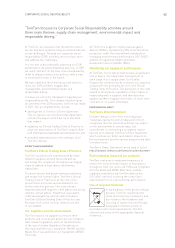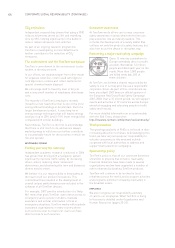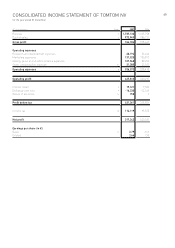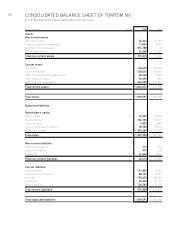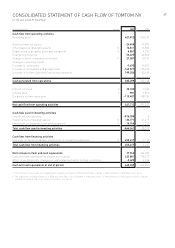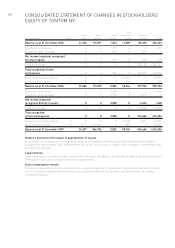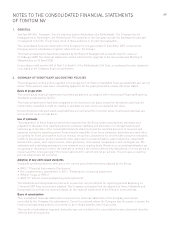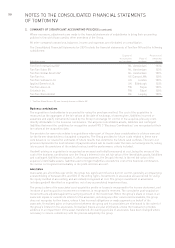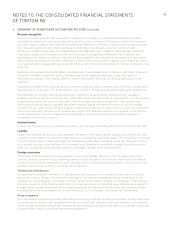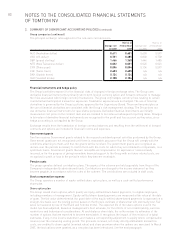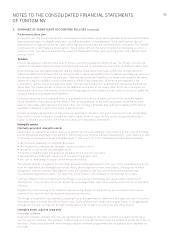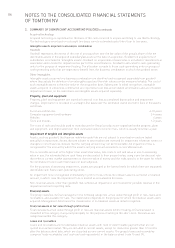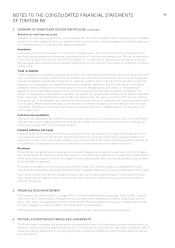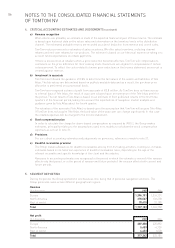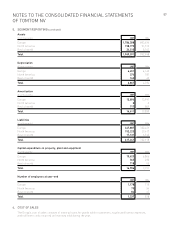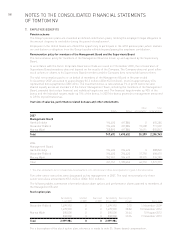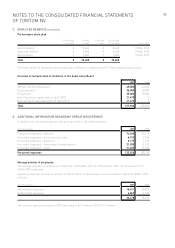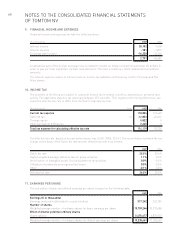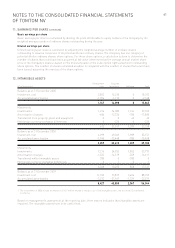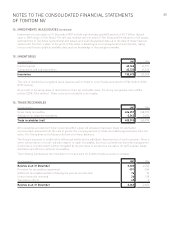TomTom 2007 Annual Report Download - page 59
Download and view the complete annual report
Please find page 59 of the 2007 TomTom annual report below. You can navigate through the pages in the report by either clicking on the pages listed below, or by using the keyword search tool below to find specific information within the annual report.
53
NOTES TO THE CONSOLIDATED FINANCIAL STATEMENTS
OF TOMTOM NV
2. SUMMARY OF SIGNIFICANT ACCOUNTING POLICIES (continued)
Performance share plan
During the year the Group introduced a share-based compensation plan, which qualifies as a cash-settled share-
based payment plan, to eligible employees, including members of management. Cash-settled share-based
payments are recognised at the fair value of the liability incurred and are expensed when consumed. The liability
is remeasured at each balance sheet date to its fair value, with all changes recognised immediately as either a
profit or a loss. Fair value is measured by using the Black and Scholes option pricing model and a Monte Carlo
pricing model.
Taxation
Income tax expense represents the sum of the tax currently payable and deferred tax. The Group’s income tax
expense is calculated using tax rates that have been enacted or substantively enacted by the balance sheet date.
Deferred taxes are calculated using the liability method. Deferred income taxes reflect the net tax effects of
temporary differences between the carrying amounts of assets and liabilities for financial reporting purposes and
the amounts used for income tax purposes. Deferred tax assets and liabilities are measured using the tax rates
expected to apply to taxable income in the years in which those temporary differences are expected to be
recovered or settled, using tax rates (and laws) that have been enacted or substantially enacted by the balance
sheet date. The measurement of deferred tax liabilities and deferred tax assets reflects the tax consequences
that would follow from the manner in which the Group expects, at the balance sheet date, to recover or settle the
carrying amount of its assets and liabilities.
Deferred tax assets are recognised when it is probable that sufficient taxable profits will be available against
which the deferred tax assets can be utilised. The carrying amount of deferred tax assets is reviewed at each
balance sheet date and reduced to the extent that it is no longer probable that sufficient taxable profits will be
available to allow all or part of the asset to be recovered.
Current and deferred taxes are recognised as an expense or income in the profit and loss account, except when
they relate to items credited or debited directly to equity. In which case, the tax is also recognised directly in
equity, or where it arises from the initial accounting for a business combination.
Intangibleassets
Internally generated intangible assets
Expenditureon research activities, such as engineering costs and software costs relating to non-core technology,
are recognised as expenses in the period in which they incur. Internal software development costs relating to core
technology are recognised as an intangible asset if, and only if, all of the following have been demonstrated:
• the technical feasibility to complete the project;
• the intention to complete the intangible asset, and use or sell it;
• the ability to use or sell the intangible asset;
• how the intangible asset will generate probable future economic benefits;
• the availability of adequate resources to complete the project; and
• the cost of developing the asset can be measured reliably.
The amount initially recognised for internally-generated intangible assets is the sum of the expenditure incurred
from the datewhen the intangible asset first meets the recognition criteria listed above. Subsequent to initial
recognition, internal software development costs are carried at cost less accumulated amortisation and
accumulated impairment losses. The useful life of the Group’s core software is estimated at four years.
Internal software costs not relating to the Group’s core software technology are expensed as research and
development costs, as incurred on the basis that on average these costs have a useful economic life of less than
one year.
Engineering costs relating to the detailed manufacturing design of new products are recorded in the income
statement as research and development expenses as incurred.
The Group is required to use estimates, assumptions and judgements to determine the expected useful economic
lives and future economic benefits of these costs. Such estimates are made on a regular basis, or as appropriate
throughout the year, as they can be significantly affected by changes in technology and other factors.
Intangible assets acquired separately
Computer software
Acquired computer software licences are capitalised on the basis of the costs incurred to acquire and bring to
use the specific software. The softwareis amortised on a straight line basis over its estimated useful life of two to
five years. Costs associated with maintaining computer software programmes are recognised as an expense as
incurred.


